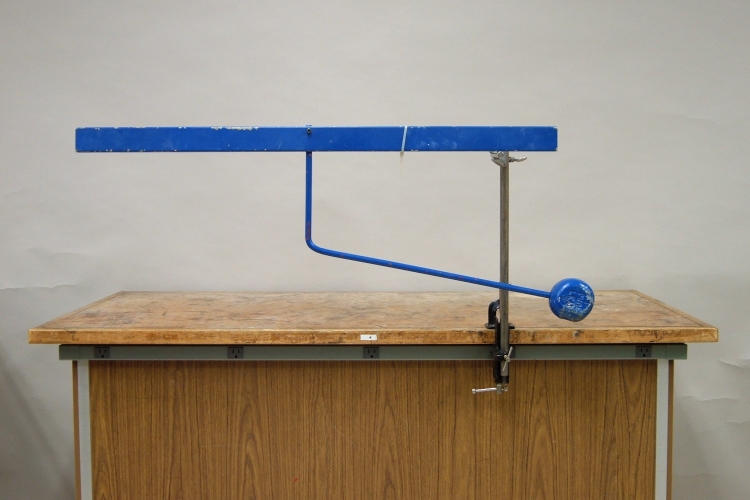
When you place the beam of this cantilever on the support rod as shown, it sits in the position at which its center of mass lies on the verical line that passes through the point of contact. If you rotate the cantilever away from this position, you displace the center of mass from the vertical line through the support point, and raise it. Gravity exerts a restoring torque to bring the center of mass back to this line. The cantilever is thus in stable equilibrium. If you move the cantilever to the left or right, the position of the beam for which the cantilever is in equilibrium changes, and it no longer rests horizontally. If the component of gravity that acts parallel to the beam overcomes friction, the cantilever will slide away from the equilibrium position. A zip tie on the beam allows you to show stable equilibrium at various points without having the beam slip on the rod.
The center of mass of an object is the weighted mean displacement of all of its mass points from some reference point, usually the origin of the coordinate system in which the object sits. This is the sum of the products of all the mass points with their distances from the origin, divided by the total mass of the object (rcm = Σmiri/M). If we set the center of mass of the object at the origin, we find that this sum equals zero. This tells us that if we exert a force on the object at its center of mass, this results in no torque on the object, but if we apply a force to the object at any other point, as long as the line of force does not go through the center of mass, we exert a torque on the object about its center of mass. If the object is relatively small, and close to the earth, then gravity acts uniformly on the object. That is, if the object is of uniform density, gravity exerts the same downward force on all of its mass points, and the sum of all of these forces is equal to a single downward force, F = Mg, acting at the center of mass of the object.
The large mass at the end of the bent rod is located so that the center of mass of the whole cantilever assembly lies along the vertical line through the support point, just to the left of the upright, about 5 cm above the center of the bent rod that connects the large mass to the beam. If you rotate the cantilever from this position, you displace the center of mass from this vertical line, which raises the center of mass and thus the gravitational potential energy. Gravity exerts a torque in the opposite direction, which when you release the cantilever, brings the center of mass back to its original position, thus lowering it and decreasing the potential energy of the system. The cantilever is thus in stable equilibrium. (See demonstration 32.20 -- Neutral, stable and unstable equilibrium).
The object in this demonstration is called a cantilever, because it extends horizontally from the point at which it is supported, with no support under the extended section.
With the cantilever suspended as shown in the photograph, as noted above, the torque exerted by the support rod about its center of mass is balanced by the torque exerted by gravity about the suspension point at the center of mass, and the cantilever is in stable equilibrium. If you place the beam so that it rests on the support rod at some other point, gravity, acting at the center of mass, causes the beam to tilt until the center of mass lies below the new suspension point. If the angle at which the beam sits is too far from horizontal, the component of gravity that is parallel to the beam could overcome friction and cause the cantilever to slide on the support rod, and thus cause it to slide away from the new equilibrium position. A zip tie around the beam provides a stop so that when you rest the beam at a different point from that shown above, the cantilever can sit in stable equilibrium with the beam tilted from the horizontal position, and not slide out of equilibrium. You can, of course, set the cantilever so that the support rod is at the corner where the rod that supports the round mass meets the beam (on the side toward the mass), and it will sit in stable equilibrium.
References:
1) Resnick, Robert and Halliday, David. Physics, Part One, Third Edition (New York: John Wiley and Sons, 1977), pp. 162-5, 283-5, 291-3.